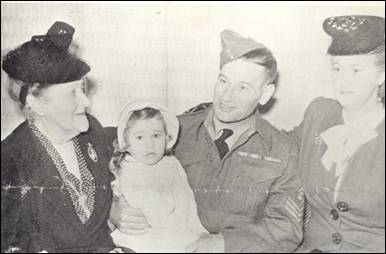|
Charles Albert Clark DCM |
|
|
|
Pvt Clark was awarded the DCM Jan 9 1957, by the Governor General for setting fire to a Japanese Ship yard while being held as a POW in Japan in WWII. He had served postwar as a Sgt with the Winnipeg Grenadiers and ended up being sent to Hong Kong. As of 1959 he was living at 4 Furnivale Ave. East York ON. I believe he originally served with the PWOR pre - WW 1. |
|
The citation for the Distinguished Conduct Medal reads Staff-Sergeant Clark of the
Canadian Postal Corps was at Headquarters of "C" Force at Hong Kong where he
displayed a high standard of courage and devotion to duty when a building in which he was
quartered received a direct hit from a heavy shell. One of his officers was killed, and
Colonel Patrick Hennessy, DSO, MC, second-in-command of "C" Force, mortally
wounded. With the assistance of another Non-Commissioned Officer, Staff-Sergeant Clark
applied tourniquets to Colonel Hennesy's legs, placed him on a door and carried him to a
spot under an iron staircase for safety. Staff-Sergeant Clark went for help, to get which
he had to pass a blazing building containing 300,000 rounds of small arms ammunition which
was exploding. The danger from flying bullets and enemy shells did not deter
Staff-Sergeant Clark who crept through this barrage and reached the Mount Austin Barracks
where an ambulance was sent for. Staff-Sergeant Clark returned under the same dangerous
conditions to Colonel Hennessy with the Medical Officer who treated him and then
Staff-Sergeant Clark assisted in carrying Colonel Hennessy on a stretcher over very rough
ground while under fire to the ambulance and accompanied him to the hospital. Following
his capture at Hong Kong in December 1941 he was interned first at Hong Kong and later
transported to Japan where he worked in the Nippon-Kokan shipyard in the Yokohama-Tokyo
area. In connection with Staff-Sergeant Clark, Commander Edward V. Dockweiler of the
United States Navy writes: "About 2000 hours, 20 January 1944, a large fire broke out
in this yard, completely destroying the steel shed, ship outfitting stores, prisoner of
war mess hall, riggers lobby, tool rooms, part of the ship fitters shop and mold loft. The
area occupied by these buildings was about 800 by 600 feet. I would estimate the damage
caused by this fire at about three-quarters to one million dollars. Aside from the
monetary damage accomplished, the production of this yard was reduced about 60 percent for
a period of at least eight months. At this time the yard was engaged in building escort
destroyers and merchant shipping. Its tonnage production was about 8,000 tons a month.
Considerable repair work also was being undertaken at this time. This fire was started by
Staff-Sergeant Clark, Canadian Postal Corps, and Private K.S. Cameron, Royal Canadian
Ordnance Corps. The method used was a candle, the bottom of which was surrounded with
celluloid shavings accumulated from soap boxes. The length of the candled determined the
time of firing. This incendiary medium was placed behind some rubbish in one of the little
used and inspected store rooms. The Japanese authorities made a very thorough
investigation of the damage caused by the above mentioned fire, but were unable to
determine its cause or the part played by these two young men effecting it. If the part
that Sergeant Clark and Private Cameron played in this sabotage had been discovered,
undoubtedly they would have been executed or tortured to death. This act of sabotage
greatly crippled the production of this yard and directly minimized the Japanese war
effort, and the contribution to the Allied war effort that these two men made under the
handicap of being prisoners of war cannot be overestimated. The occurrence of this fire is
part of my official report to my own Navy Department. I submit this report to your office
with the recommendation that this act of Sergeant Clark and Private Cameron be properly
recognized and adequately rewarded. Their conduct as prisoners of war while under my
jurisdiction was exemplary and fulfilled the highest tradition of the Canadian Army".
|
|
Photo and information courtesy of Steve Nichol |
